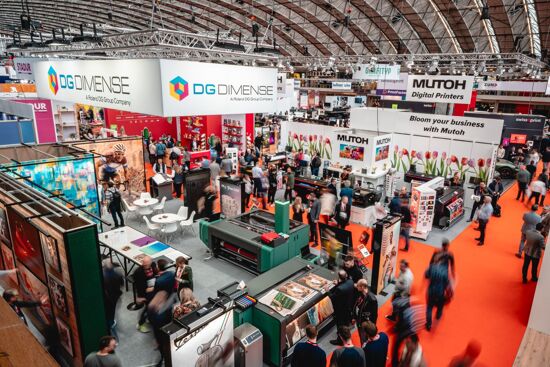Empowering Creatives with Digital Print Technologies
.jpg?width=750)
FESPA’s Textile Ambassador Debbie McKeegan discusses how digital print technologies have empowered a new generation of creatives
It’s not just the high street that has seen a massive reform in the way consumers buy Fashion and Homeware products. Whilst retail giants, large and small have adapted to embrace a new generation of tech savy consumers, creative digital nomads are also changing the demographic of traditional textiles.
Empowered by digital textile print technologies, Designers are adopting new routes to market for their textile designs.
With the evolution of the online product marketplace, came a new era of commercial opportunities for ecommerce entrepreneurs. Offering the creative a myriad of platforms with which to connect to a new breed of buyer whilst enabling designers to sell their patterns as printed products online direct to the consumer. The success stories of such platforms are numerous. The online product marketplace has facilitated a new breed of designer-maker and in doing so has also nurtured commercial confidence within the design community itself. Many fledgling designer brands begin to trade in this format, and once established move on to create their own online identity, websites, and their own independent retail platforms.
.jpg?width=800&height=625)
Caption: The English Garden Collection: Designed by Keighley Clay
Image credit: Keighley Clay
Textile buyers for large retailers of both Fashion and Homeware manufacturers have also changed their working practice. Many now prefer to buy design artwork online. In a fast-paced world of instant trends and customized manufacture, there simply isn’t time to plan seasons ahead. Access to high quality (print ready) design that’s available for instant download is a must have resource for the millennial manufacturer, and online design studios see exponential growth worldwide.
We are also witnessing a new breed of Digital Design Studio. Selling designs by the metre to Fashion and Home furnishing buyers. Customized manufacture has created an insatiable demand for innovative design, with instant availability. Textile Design studios now offer their patterns as cut-length fabrics or exclusive print-runs to both the Fashion and Home Décor industry.
Some rely on a network of digital textile print bureaus to do so, placing small (10-1000m) orders on demand when orders are received. Others have invested in their own digital print technology and with the advancement of practical, entry-level, affordable machinery this entrepreneurial sector of the creative market place is set for huge growth.
Compared to the traditional manufacturing route, whereby the designer would sell the painted artwork to the buyer who would then have to enable production, this new form of association benefits both sides. The designer gains extra margin by selling fabrics direct, and the buyer has access to thousands of designs that are print ready and available printed onto any fabric, on demand, with no need for an in-house design team. Speeding up the supply chain and offering an efficient sourcing platform.
.jpg?width=800&height=625)
Caption: Velvet cushions by Keighley Clay, a young british designer and graduate of Central St. Martins, London
Image Credit: Keighley Clay
Fashion designers are also selling direct to the consumer or retailer. Richard Quinn started his company just three years ago. A student of Central St. Martins, London, he embraced digital print technologies during his university education and saw that flexible, in-house manufacturing would allow him to build an independent brand. With the support of the print machine community and its supply chain, he did just that, collaborating with Epson to build his in-house production facility. Quinn has forged a successful, privately owned Fashion empire with worldwide acclaim, even receiving an award from HM the Queen in 2018.
In todays online world anything is possible for the talented creative with the drive to succeed.
Keighley Clay began her design career at Liberty. Beginning as an intern she went on to become an in-house textile designer. Learning her trade in one of the UK’s oldest textile manufacturers and alongside a design team with huge knowledge and textile heritage has stood her in good stead. Liberty utilize digital textile technology to facilitate sampling for all their patterns and textile prints, which offers a sustainable solution to textile sampling by saving valuable time in post-production compared to utilizing analogue technology. As a young designer, Keighley also saw the commercial opportunities for her own brand. A talented designer, and alongside her husband, she now runs her own design company and online retail store selling her designs as homeware products worldwide.
.jpg?width=800&height=625)
Caption: Digital Print Technologies have empowered a new generation of creatives
Image credit: Keighley Clay
Established brands and Textile manufacturers too are embracing Digital Textile technology. As many companies, in Fashion and Home Furnishings struggle to achieve viable margins against buyers expectations, digital technology offers an efficient solution by controlling inventory. Reducing stocks of printed fabrics, and offers diversity and flexible manufacturing. Brands that once outsourced their printed fabrics are now investing in digital textile print technology and re-skilling their workforce to offer their customers in-house print and critically, speed of manufacture. Millennial manufacturing doesn’t allow, nor can it afford, vast stocks. The successful business of the future needs to have a sustainable supply chain if it is to appeal to the modern consumer.
Digital Print Technologies continue to disrupt the print industry worldwide, but we are only at the very beginning of a radical reform in the Textile sector.
The Textile Industry is witnessing the beginnings of a shift away from traditional sourcing routes across all sectors of our Industry, from Fashion to Interiors, as our routes to market evolve to meet the needs of a new thirst for customized manufacturing and design diversity
Digitally Printed Textiles represent approximately 7% of our worldwide printed textile market volume. We really are at the very beginnings of a Digital Reform that will offer our industry a creative, sustainable future…
Topics
Interested in joining our community?
Enquire today about joining your local FESPA Association or FESPA Direct
Recent news

FESPA 2025 Feature Programme confirmed: both new and returning
FESPA Global Print Expo 2025 is set to introduce its newest editions to its feature programme, SmartHub and the ESE Pavilion, as well as welcome the return of existing features: the 2025 FESPA Awards; the high-adrenaline World Wrap Masters competition; and the Club FESPA Lounge.
.png?width=550)
My Personalisation Experience
Richard Askam, a pioneer in Personalisation, transitioned from the drinks industry to creating iconic campaigns like Coca-Cola's "Share a Coke." His speaking career, includes leading a TEDx talk, becoming an ambassador for FESPA . In the past, he has led the conference sessions for the Personalisation Experience" conference, and will return this year to speak in a panel discussion.

What Does LED Lighting Do for Your Textile Frame?
LED lighting transforms textile frames, enhancing visibility and colour vibrancy for impactful displays. At European Sign Expo 2025, EFKA will showcase innovative illuminated and non-illuminated frames, including 3D and modular designs. LED's energy efficiency and storytelling potential make them crucial for modern visual communication.
